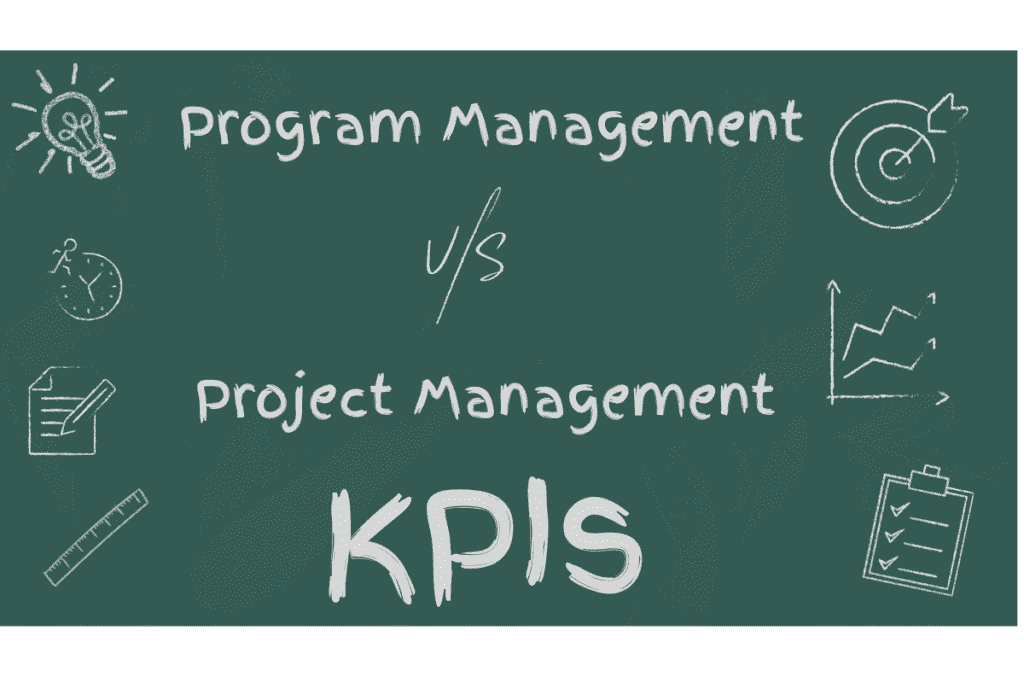How Program Management KPIs are Different From Project Management KPIs
Imagine steering a ship without a compass or flying a plane without a radar. That’s what managing a project or program without key performance indicators (KPIs) feels like. While KPIs are the guiding stars in the vast sky of management, not all stars shine the same. Dive into the nuanced world of Program Management KPIs and discover how those used in program management differ from those in project management.
What is the difference between Program Management and Project Management KPIs (Key Performance Indicators)?
The distinction between Program Management and Project Management KPIs hinges on their line of sight and message. Program Management KPIs offer a macro view, mapping to overarching business objectives and gauging delivery against broader business value. In contrast, Project Management KPIs present a micro perspective, aligning specifically with project objectives and assessing delivery against distinct project goals.
While the terms “program management” and “project management” are often used interchangeably, they serve different purposes. Program management oversees a group of related projects or initiatives aimed at achieving a strategic objective. In contrast, project management focuses on individual projects, ensuring specific deliverables are met within a defined timeline and budget.
Given their distinct scopes, the KPIs for program and project management also differ. Program management KPIs measure the overall progress and value delivery of the entire program, while project management KPIs track the performance of individual projects.
What value will a reader get from reading this article?
By reading this article, readers will gain a clear understanding of the differences between program management and project management KPIs. They will learn what these KPIs measure and how they are aligned with the goals and objectives of the respective disciplines. This knowledge will enable them to effectively measure and evaluate the success of their programs and projects.
 How Do Program vs Project KPIs to Measure Success?
How Do Program vs Project KPIs to Measure Success?
Programs and Projects use similar metrics, but use specific KPIs to measure them differently. These KPIs are provided in updates via status reports and status calls to stakeholder to keep them updated on progress. A Program status report is not a summary of the projects in the program, but rather how the overall program is performing at a strategic level to accomplish a business goal. Resources (both human and dollars) may be shifted between projects by a Program Manager to achive the overall Program objectives.
The line of sight of how goals, metrics and measurements are viewed at each level is provided below.
Program Management Goals, Metrics and Measurements
Program management focuses on the alignment of projects and initiatives with organizational objectives and strategic goals. The goals of program management often include delivering business value, achieving organizational benefits, and optimizing resource utilization. Key program management metrics and measurements include:
- Financial performance, such as return on investment (ROI), cost performance index (CPI), and budget variances.
- Resource utilization and availability, including staffing levels and allocation.
- Benefits realization and value delivery, such as benefits realization index (BRI) and business value achieved.
- Risk management, including risk identification, assessment, and mitigation.
- Stakeholder satisfaction and engagement, measured through surveys and feedback.
Overview of Project Management Goals, Metrics and Measurements
Project management, on the other hand, focuses on delivering specific project outcomes within defined constraints. The goals of project management typically include delivering the project scope on time, within budget, and meeting stakeholder expectations. Key project management metrics and measurements include:
- Schedule performance, such as schedule performance index (SPI), on-time delivery, and project schedule variance.
- Cost performance, including cost performance index (CPI), budget variance, and actual vs. planned costs.
- Quality management is measured through defect rates, customer satisfaction, and compliance with quality standards.
- Scope management, such as scope creep, change requests, and project requirements adherence.
- Risk management, including risk identification, assessment, and mitigation.
- Resource management, such as resource utilization, productivity, and availability.
 What are Some Helpful KPIs for Project Management and Program Management?
What are Some Helpful KPIs for Project Management and Program Management?
KPIs are essential tools for both project and program managers. They provide insights into the health and progress of their tasks. These indicators also highlight the success of their specific endeavors. While both use similar KPIs, their application varies. This difference stems from the tactical approach of projects and the strategic orientation of programs.
For project managers, KPIs often center on the triple constraints of scope, time, and cost. They ensure projects meet the specified requirements, stay within budget, and finish on time. On the other hand, program managers utilize KPIs to ensure that the collection of projects under the program umbrella collectively deliver strategic value and benefits to the organization.
What are Some Project Management KPI Types with Examples?
Why KPIs are important in Project Management
Actionable KPIs are crucial in project management as they provide a clear and measurable way to assess progress and increase project success. They help project managers identify any issues or potential risks early on to manage project performance. KPIs help every project manager by, allowing them determine if the project progress is on track, take corrective actions based on measurable performance indicators, and ultimately complete a project on track.
Types of KPIs in Project Management
There are several types of KPIs used in project management, including:
- Cost-related KPIs: These KPIs focus on measuring the project’s financial performance, such as cost performance index (CPI), project budget variances, and actual vs. planned costs.
- Schedule-related KPIs: These KPIs measure the project’s progress in terms of meeting deadlines, such as schedule performance index (SPI), on-time delivery, and project schedule variances.
- Quality-related KPIs: These KPIs assess the project’s adherence to quality standards and customer satisfaction, including defect rates, customer feedback, and compliance with quality requirements.
- Risk-related KPIs: These KPIs focus on identifying and managing project risks, such as risk identification rate, risk impact assessment, and risk mitigation effectiveness.
Project Management KPI Examples
By leveraging these KPIs, project managers can gain a comprehensive view of their project’s health and make informed decisions to ensure successful project delivery.
- Task Completion Rate: Measures the percentage of tasks completed against those planned for a specific period.
- Resource Allocation Efficiency: Assesses how effectively resources (both human and material) are utilized in the project.
- Change Request Frequency: Tracks the number of change requests made during the project, indicating potential scope changes or adjustments.
- Stakeholder Engagement Level: Evaluates the frequency and quality of interactions with key project stakeholders, ensuring their needs and concerns are addressed.
- Project Milestone Adherence: Monitors the achievement of critical project milestones against the planned timeline.
- Issue Resolution Time: Measures the average time taken to resolve project issues or challenges, indicating the project team’s responsiveness and efficiency.
- Team Satisfaction Score: Gathers feedback from the project team to assess their satisfaction levels, which can impact project morale and outcomes.
What are Some Program Management KPI Types with Examples?
Why KPIs are important in Program Management
KPIs play a significant role in program management as they help program managers to track and evaluate the overall progress, success, and value delivery of the program. They provide valuable insights into the alignment of projects and initiatives with organizational objectives and help in ensuring that the program stays on track to achieve its intended outcomes.
Types of KPIs in Program Management
In program management, we use various types of KPIs to measure a program’s performance and success. These include:
- Financial KPIs: These KPIs focus on measuring the financial performance and value delivery of the overall program, such as return on investment (ROI), cost performance index (CPI), and budget variances.
- Benefits realization KPIs: These KPIs assess the achievement of program benefits and the value delivered to the organization, including benefits realization index (BRI), business value achieved, and benefits adoption rate.
- Stakeholder satisfaction KPIs: These KPIs measure the satisfaction and engagement levels of program stakeholders, providing valuable insights into the perception of the program’s success and value.
- Risk management KPIs: These KPIs focus on identifying, assessing, and managing program risks to ensure the smooth execution and successful delivery of the program’s outcomes.
Program Management KPI Examples
By leveraging KPIs, program managers can maintain a strategic overview of their program. Ensuring a program remains strategically aligned with business objectives and delivers maximum value to the organization is key to a Program Manager. These are some KPI’s that can help achieve that goal. Some of these are common in the industry, and some have been developed independently in practice to provide extra value.
- Program ROI (Return on Investment): Calculates the financial return generated by the program relative to its total cost, emphasizing the program’s value delivery.
- Benefits Realization Rate: Assesses the percentage of intended benefits (both tangible and intangible) that have been realized by the program to date.
- Program Health Index: A composite metric that evaluates various aspects of the program, such as stakeholder satisfaction, financial performance, and risk management effectiveness, to provide an overall health score.
- Strategic Alignment Score: Measures how closely the program’s outcomes and deliverables align with the organization’s overarching strategic objectives.
- Program Schedule Adherence: Monitors the progress of the program against its planned timeline, considering all underlying projects and their interdependencies.
- Stakeholder Engagement and Satisfaction Level: Evaluates the frequency, quality, and outcomes of interactions with key program stakeholders, ensuring their strategic needs and concerns are addressed.
- Program Risk Exposure: Assesses the potential impact and likelihood of identified program risks, ensuring that mitigation strategies are in place for high-exposure risks.
- Resource Optimization Index: Measures the efficiency of resource allocation and utilization across all projects within the program, ensuring that resources are used where they can deliver the most value.
- Cross-Project Dependency Management: Tracks the management and resolution of dependencies between projects within the program, ensuring smooth coordination and timely delivery.
How Do Project Status Reports VS Program Status Reports Enable Stakeholder Alignment?
A common misconception is that program status reporting is merely a summary of its constituent projects. In reality, it’s a strategic overview of how the entire program is progressing towards delivering business value.
While projects focus on the triple constraint (scope, time, and cost), program management elevates this to a strategic level. Program Managers need to ensure resources, both human and financial, are optimally allocated to serve the program’s objectives. If one project faces challenges, a Program Manager might reallocate resources from another project, ensuring the program stays on track, even if individual projects shift.
This strategic approach is evident in status updates. A program status report isn’t a detailed breakdown of each project but a high-level view of the program’s health, risks, and alignment with business objectives. It’s about communicating the program’s value delivery to stakeholders, not just task completions.
In practice, achieving success in program management requires a keen understanding of both program and project management principles. Regular alignment meetings with business stakeholders ensure the program stays on track with strategic objectives. Simultaneously, sync-ups with project managers help in understanding ground realities, risks, and opportunities.
This dual focus ensures that while projects address their tactical challenges, the program remains steadfast in its strategic pursuit.
Is the Software for Program Management Software to Track KPIs?
While program management and project management share similarities, the software used for tracking and managing them may differ. There are dedicated program management software solutions that are designed to handle the complexities and nuances of managing multiple projects and initiatives within a program. These software solutions often provide features such as program-level KPI dashboards, cross-project resource allocation, and benefits realization tracking.
On the other hand, project management software typically focuses on managing individual projects. It provides tools for creating project plans, tracking progress, managing resources, and generating project status reports. While some project management software may offer basic program management features, they may not provide the same level of functionality as dedicated program management software.
Conclusion
In conclusion, understanding the differences between program management and project management KPIs is crucial to measure performance and evaluating progress. While both disciplines use KPIs to track progress and success, their objectives and scope vary.
By utilizing the right KPIs and leveraging appropriate management software, project and program managers can ensure the successful delivery of projects and programs, ultimately driving organizational success.
If you liked this article, remember to subscribe to MiamiCloud.com. Connect. Learn. Innovate.







